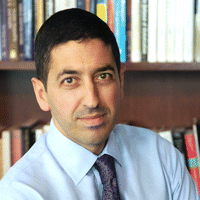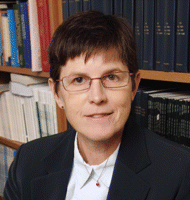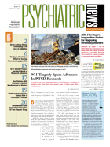Barely an hour after two hijacked planes struck the World Trade Center in lower Manhattan, posttraumatic stress disorder (PTSD) researcher Rachel Yehuda, Ph.D., got a call from the New York Times asking for her views on the likely mental health outcomes of the event.
At that moment, no one knew if other attacks were imminent. A life-or-death situation was not the time for mental health interventions, she informed the reporter.
"We'll have plenty of time to worry about that," said Yehuda, a professor of psychiatry and neuroscience and director of the Traumatic Stress Studies Division at Mount Sinai School of Medicine.
In the years since the events of September 11, a small army of researchers has sought to document the psychological responses to the attacks and to understand the origins of those responses and the consequences of a grim natural experiment.
"At the time of the attacks, we didn't know enough about the population consequences of these large-scale events," said Sandro Galea, M.D., Dr.P.H., a professor and chair of the Department of Epidemiology at Columbia University's Mailman School of Public Health.
Research began on a relatively modest scale, but that changed over time, said Galea, who has published dozens of studies tied to September 11.
"One thing that changed was that while much earlier research was conducted by small teams, more recent longitudinal work has demanded large study cohorts, like that of New York City's World Trade Center Health Registry," said Galea. The registry documents the health of 71,000 people.
"This is not atypical for a maturing research field," said Galea.
Over the last decade, researchers have looked at everything from epidemiology to biology related to the events' mental health sequelae.
A recent systematic review of the literature on PTSD after the attacks published online August 8 in American Psychologist, while addressing just that one diagnosis, provides insight into the scope of research.
Data Depended on Population Studied
The prevalence of PTSD varied depending on the exposed population under study, concluded Yuval Neria, Ph.D., a professor of clinical psychology at Columbia University in the departments of Psychiatry and Epidemiology and director of trauma and PTSD at the New York State Psychiatric Institute, and colleagues, in the review. They noted that while many studies reported on "PTSD," most used nonclinical assessments, and the results should be considered as "probable PTSD."
In one sample of New York City's population, prevalence was as low as 1.5 percent six months after the attack. Among those directly exposed to the attacks, however, prevalence rates of 11 percent to 12 percent were found a year later in cross-sectional studies. The few longitudinal studies surveyed varied too, with some showing declines over time and others not.
Some subpopulations recorded even higher rates of PTSD. About 22 percent of retired firefighters and 35 percent of 204 Chinatown schoolchildren (who lived very near to ground zero) reported PTSD symptoms 2.5 years after September 11. However, another study of 8,236 New York City schoolchildren reported a PTSD prevalence of 10.6 percent.
Also, PTSD in several studies was eight times more prevalent among low-salaried individuals than in higher-paid ones, and some studies showed higher rates among Hispanics compared with other racial or ethnic groups.
A major question for Neria and colleagues as they reviewed the literature was the variety of assessment tools (mostly questionnaires or screens, but not formal diagnoses) used to screen for PTSD, as well as varying ways of measuring covariates and mediators.
"Few studies used longitudinal study design or clinical assessments, and no studies reported findings beyond six years post-9/11, thus hindering documentation of the long-term course of confirmed PTSD" or the effects of treatment, they pointed out. Nevertheless, those studies have helped advance the understanding of disasters because of their scale and representativeness. They also provided helpful data on PTSD estimates relatively soon after 2001.
Yehuda had been studying PTSD since 1988, and she knew that many questions would arise in the aftermath of the attacks, questions that had not at that time been fully answered by the research community.
"My inner thought was that most people would be fine, and the greater need would appear down the road," she said in a recent interview with Psychiatric News.
Who Will Need Mental Health Care?
A core question for her and many other researchers studying postdisaster mental health was how to figure out shortly after an event just who will eventually need professional help. Who in the immediate aftermath of the event and who in the longer term will be at greatest risk for psychological problems? Who should be treated and for what? When is the best time to do research—as a disaster unfolds or in the aftermath?
Much work by Yehuda and others has looked at gene-expression patterns. For example, FKBP5, a gene associated with cortisol release and the control of glucocorticoid function, is expressed less in people with PTSD than in people in the general population.
Study of genetics and other biological or environmental factors, such as previous trauma, as predisposing factors is one of the most interesting areas of research for Galea.
"People are trying to understand the complexity of causation," he said. "How the environment gets together with the individual, how together they can change the expression of a particular genetic code, and how that becomes pathological."
Meanwhile, at the epidemiological end of the research scale, one recent study found that 35 percent of those in the towers, 20 percent of those witnessing death or injury (usually within 0.1 mile), and 35 percent of those with close associates who were endangered developed PTSD, using DSM-IV-TR diagnostic criteria.
However, PTSD symptoms among persons without such exposure were likely due to reasons other than the attacks, wrote Carol North, M.D., a professor of psychiatry at the University of Texas Southwestern Medical Branch in Dallas, and several colleagues to be published in the journal Disaster Medicine and Public Health Preparedness (vol. 5/suppl. 2).
"Outside these exposure groups, few possible sources of exposure were evident among the few individuals who were symptomatic, most of whom had preexisting psychiatric illness," concluded North and colleagues.
Continuing research at both the molecular and the population levels will improve planning of services and provision of care following major disasters.
An abstract of "Posttraumatic Stress Disorder Following the September 11, 2001, Terrorist Attacks: A Review of the Literature Among Highly Exposed Populations" is posted at <www.ncbi.nlm.nih.gov/pubmed/21823772>. Footnotes
This is a continuation of a series of articles in Psychiatric News exploring the mental health aftermath of the September 11, 2001, terror attacks.




